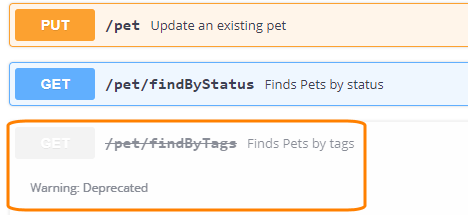路徑與操作
在 OpenAPI 術語中,路徑 是端點(資源),例如 /users 或 /reports/summary/,您的 API 會公開這些端點,而操作 則是用於操作這些路徑的 HTTP 方法,例如 GET、POST 或 DELETE。
路徑
API 路徑和操作在 API 規格的全域 paths 區段中定義。
1paths:2 /ping: ...3 /users: ...4 /users/{id}: ...所有路徑都相對於 API 伺服器 URL。完整的請求 URL 結構為 <server-url>/path。全域 servers 也可以在路徑層級或操作層級覆寫(詳細資訊請參閱下方)。路徑可以有選用的簡短 summary 和較長的 description,以用於文件用途。此資訊應與此路徑中的所有操作相關。description 可以是多行,並支援 Markdown (CommonMark) 以呈現豐富文字。
1paths:2 /users/{id}:3 summary: Represents a user4 description: >5 This resource represents an individual user in the system.6 Each user is identified by a numeric `id`.7
8 get: ...9 patch: ...10 delete: ...路徑範本
您可以使用大括號 {} 將 URL 的部分標記為路徑參數
1/users/{id}2/organizations/{orgId}/members/{memberId}3/report.{format}API 用戶端在發出 API 呼叫時需要提供適當的參數值,例如 /users/5 或 /users/12。
操作
針對每個路徑,您可以定義可用於存取該路徑的操作(HTTP 方法)。OpenAPI 3.0 支援 get、post、put、patch、delete、head、options 和 trace。單一路徑可以支援多個操作,例如 GET /users 以取得使用者清單,而 POST /users 則新增使用者。OpenAPI 將路徑和 HTTP 方法的組合定義為唯一的操作。這表示不允許對同一路徑使用兩個 GET 或兩個 POST 方法,即使它們具有不同的參數(參數對唯一性沒有影響)。以下是操作的最小範例
1paths:2 /ping:3 get:4 responses:5 "200":6 description: OK以下是更詳細的範例,包含參數和回應結構描述
1paths:2 /users/{id}:3 get:4 tags:5 - Users6 summary: Gets a user by ID.7 description: >8 A detailed description of the operation.9 Use markdown for rich text representation,10 such as **bold**, *italic*, and [links](https://swagger.dev.org.tw).11 operationId: getUserById12 parameters:13 - name: id14 in: path15 description: User ID16 required: true17 schema:18 type: integer19 format: int6420 responses:21 "200":22 description: Successful operation23 content:24 application/json:25 schema:26 $ref: "#/components/schemas/User"27 externalDocs:28 description: Learn more about user operations provided by this API.29 url: http://api.example.com/docs/user-operations/30
31components:32 schemas:33 User:34 type: object35 properties:36 id:37 type: integer38 format: int6439 name:40 type: string41 required:42 - id43 - name操作也支援一些選用元素,以用於文件用途
- 簡短的
summary和較長的description,說明操作的功能。description可以是多行,並支援 Markdown (CommonMark) 以呈現豐富文字。 tags– 用於依資源或任何其他限定詞,以邏輯方式分組操作。請參閱使用標籤分組操作。externalDocs– 用於參考包含其他文件的外部資源。
操作參數
OpenAPI 3.0 支援透過路徑、查詢字串、標頭和 Cookie 傳遞的操作參數。您也可以為將資料傳輸到伺服器的操作定義請求主體,例如 POST、PUT 和 PATCH。如需詳細資訊,請參閱描述參數和描述請求主體。
路徑中的查詢字串
查詢字串參數不得包含在路徑中。它們應改為定義為查詢參數。
不正確
1paths:2 /users?role={role}:正確
1paths:2 /users:3 get:4 parameters:5 - in: query6 name: role7 schema:8 type: string9 enum: [user, poweruser, admin]10 required: true這也表示不可能有多個僅在查詢字串中不同的路徑,例如
1GET /users?firstName=value&lastName=value2GET /users?role=value這是因為 OpenAPI 將路徑和 HTTP 方法的組合視為唯一的操作,而額外參數不會使操作變成唯一。您應該改為使用唯一的路徑,例如
1GET /users/findByName?firstName=value&lastName=value2GET /users/findByRole?role=valueoperationId
operationId 是選用的唯一字串,用於識別操作。如果提供,這些 ID 在您的 API 中描述的所有操作中必須是唯一的。
1/users:2 get:3 operationId: getUsers4 summary: Gets all users5 ...6 post:7 operationId: addUser8 summary: Adds a new user9 ...10/user/{id}:11 get:12 operationId: getUserById13 summary: Gets a user by user ID14 ...operationId 的一些常見使用案例如下
- 某些程式碼產生器會使用此值來命名程式碼中對應的方法。
- 連結可以透過
operationId參考連結的操作。
已棄用的操作
您可以將特定操作標記為 deprecated,以表示它們應逐步淘汰
1/pet/findByTags:2 get:3 deprecated: true工具可能會以特定方式處理已棄用的操作。例如,Swagger UI 會以不同的樣式顯示它們

覆寫全域伺服器
全域 servers 陣列可以在路徑層級或操作層級覆寫。如果某些端點使用與 API 其餘部分不同的伺服器或基礎路徑,這會很有用。常見範例如下
-
用於檔案上傳和下載操作的不同基礎 URL。
-
已棄用但仍可運作的端點。
servers
1paths:2 /files:3 description: File upload and download operations4 servers:5 - url: https://files.example.com6 description: Override base path for all operations with the /files path7 ...8
9/ping:10 get:11 servers:12 - url: https://echo.example.com13 description: Override base path for the GET /ping operation










